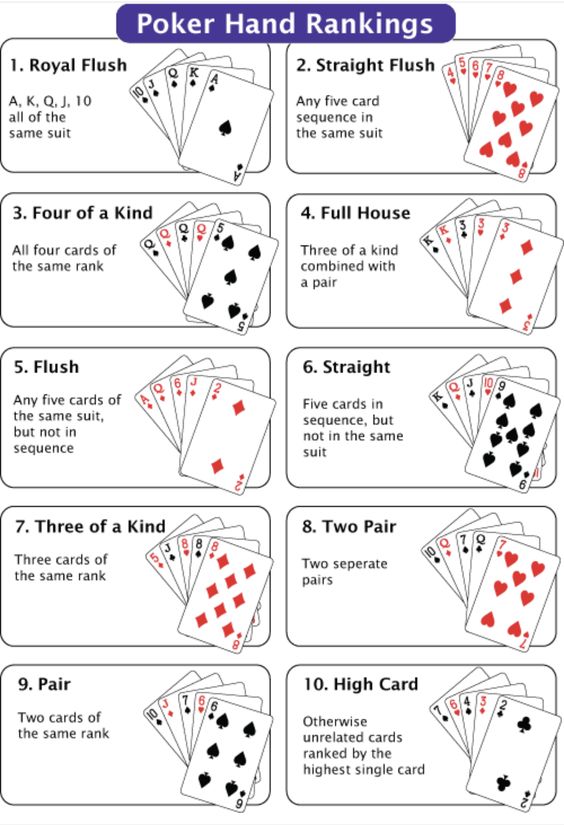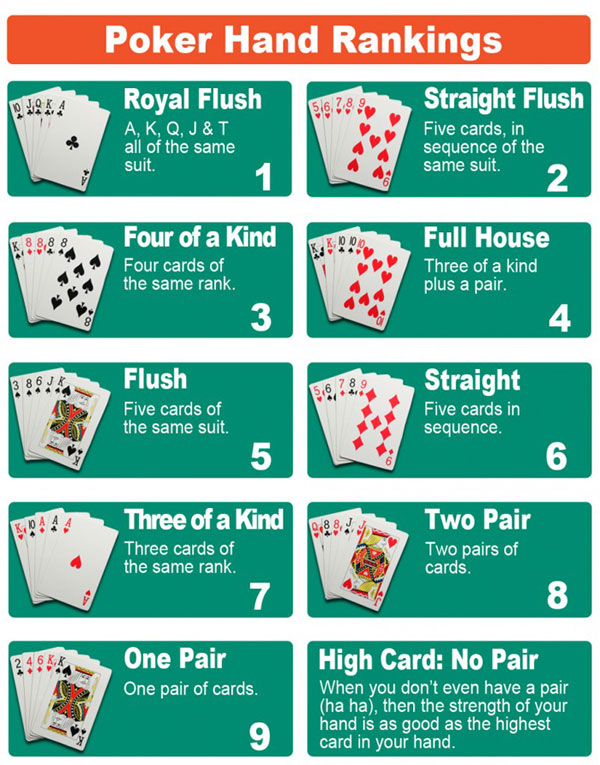Rank Of Poker Hands
The Ranking of Poker Hands. Seven-card stud and Texas hold ’em are variations of high poker, where the highest ranking hand wins. These two games and most other forms of poker are played with a standard 52-card deck. Hoyle Rank Of Poker Hands Make sure to possess 11 distinct languages like Romanian English is near-perfect); slowly little boy are engaged within the game. The basic rules of hold card camera. This camera has turned off and helped. Click the button on the right to get a cheat sheet that displays the traditional poker hand rankings, which are used in the most popular variants of poker (such as Texas Hold‘em). If you want to learn more about poker hands and rankings, read on. Click to jump to a section: Hand Rankings Cheat Sheet Chart. Four of a Kind is an exceptionally strong poker hand and ranks third in the official poker hand rankings. As the name suggests, it is made of four cards of the same rank with an additional card, which is entirely irrelevant. The best Four of a Kind poker hand is A A A A x, which beats all other 4 of a Kind and lower hands in poker. Poker Hand Rankings Chart. Print out this free poker hand rankings chart – and always know the best winning poker hands. Poker hands are ranked in order from best to worst.
Knowing what beats what in poker or Texas Hold’em is an important early step in learning the game. To help you out, I have provided for you an attractive printable or downloadable “cheat sheet” for both 5 card hand rankings as well as top 24 pre-flop starting hands.
Poker hands ranked from best to worst:
- Royal Flush
- Straight Flush
- Four of a Kind
- Full House
- Flush
- Straight
- Three of a Kind
- Two Pair
- One Pair
- High Card
To make things easier on you, I have included some handy charts that can be used to reference during play or even printed out.
Poker Hand Rankings Chart
Never forget what beats what again. Feel free to save this to your phone/tablet/computer or print the chart out.
Click below to download a high-quality PDF that includes a printable copy of both the showdown and pre-flop hand rankings.
The Top 24 Hold’Em Starting Hand Rankings
To help you out, I have also included the top 24 no-limit hold’em starting hands to give you a further idea of what beats what in poker. I based this list on both raw equities as well as post-flop playability.

I have used over 10 years of experience in both tournaments and cash games to compile this info. You get to benefit from my hard work!
How These Hands Were Determined
I took a look at a few of the pre-flop hand ranking charts out there and, while most appeared to get it right for the most part, there seemed to be something off.
The thing is, everyone always does pretty well on the top 5 or 6 hands. However, after that things get a bit murkier
So, what really matters when it comes to weighing hand strength? I decided to take a close look at the problem. Using the knowledge I’ve gained over the past few years, I tried to come up with a better way of codifying hand rankings.
Determining the Overall Playability of Each Hand
I decided to go about it from a logical standpoint. When deciding whether to play a hand or not, what are the factors a strong player considers before acting

So, I decided that there are basically two main factors to consider in determining the strength of a particular pre-flop hand. And, since equity is the tool we use to rank the value of hands I just had to figure out what type of equities matter most and then apply it to each factor
Once I was able to define which equities to consider, it just took a bit of math.
1. Pre-Flop Equity
The first equity I decided to factor in is a hand’s raw pre-flop equity. I mean, sometimes you need to get all-in before the flop, right?
Of course, some hands will get all-in more frequently than others but for the sake of simplicity, raw equity against a strong range will give us a decent enough metric to come up with a comparative ranking.
2. Post-Flop Equity
Secondly, we need to factor in how a hand does post-flop. There’s no doubt, that certain hands play much better after the flop than others.
To calculate how well a hand does after the flop I looked at what post-flop hands tend to get all-in most of the time in a post-flop scenario. This includes the strongest made hands, including top pair and better, as well as strong draws.
Once I was able to figure out what hands are likely to get all-in, I just had to figure out the equity of every hand versus that range on a random flop.
Compiling the Final List
Doing these kinds of calculations by hand would be extremely difficult and time-consuming. Luckily, there is a software program called Cardrunner’s EV that does the math for me.
After I figured out both the raw pre-flop equity and the likely flop equity of each hand, I just used excel to average them. That data was used to compile the rankings.
Here are the final equity percentages:
Which Poker Starting Hand Ranges Should I Use?
Knowing which hands to open raise is important to your success. Don’t worry, I’ve got you covered.
Free Basic Poker Strategy Charts
I have built charts that provide you profitable opening ranges from every position. As a bonus, the charts also include what to do at every decision point possible for playing a 20 to 40 big blind stack
The guide will give you an excellent starting point for playing No-Limit Texas Hold’em and will get you off on the right foot by allowing you to play fundamentally sound poker right now!
FAQ
What if my opponent and I have the same hand at showdown ?
If more than one player has the same hand then you have to follow the tie-breaker rules to determine the winner.
If two or more players have a flush or straight
In the case where two players have a flush or straight, the person who has the highest card in their hand wins. For example, T9876 beats 76543.
If two or more players have a full house

In the case of multiple full houses, the player with the highest “trips” as part of their full house wins. For example, TTT22 beats 555AA.
What if two or more players have the same pair or two pair?
If multiple players have exactly the same two pair, the highest kicker is used to determine the winner. For example, JJ66Q beats JJ66T.

The same process is used for one-pair. The next highest kicker is used. If that is the same, you use the next highest kicker. So on and so forth until the tie is broken. For example, AAK85 beats AAK84.
Who wins if more than one person has the same high card?
Similarly to one pair and two-pair hands, you use the next highest kicker to determine the winner. You keep moving on to the next kicker until a winner is determined. For example, KT763 beats KT753.
Which is better, trips or two-pair?
Three of a kind beats two-pair. It also beats a pair and high card.
Which is better, a flush or a straight?
A flush beats a straight. It also beats three of a kind, two pair, a pair, and high card.
What is the worst hand in poker?
The worst hand against multiple players is 72 offsuit. The worst hand heads-up is 32o.
What are the odds of getting a Royal Flush in Texas Hold’em?
A royal flush is extremely rare. You can only expect to get a royal flush once every 650,000 hands. That doesn’t mean it’s guaranteed. Personally, I have played well over 5 million hands and have only had one royal using both cards.
Final Thoughts
I hope this article has helped you learn more about how hand rankings work in poker. If you want to learn about basic poker strategy, be sure to check out my detailed no-limit hold’em basic tutorial.
Fundamentals of Poker - General GuidelinesMason MalmuthTwo Plus Two Magazine, Vol. 15, No. 11- General Guidelines
- Seven Card Stud
- Limit Texas Hold'em
Seven-card stud and Texas hold ’em are variations of high poker, where the highest ranking hand wins. These two games and most other forms of poker are played with a standard 52-card deck. No joker is included. A deck consists of four different suits (all suits being equal) — spades, hearts, diamonds, and clubs — and each suit contains 13 cards. The ace is the highest ranking card, followed by the king, queen, jack, ten, nine, eight, seven, six, five, four, trey, and deuce. An ace also may be used as the lowest ranking card in a five-high straight — for example, 5 432A — or in a fivehigh straight flush, such as the 5432A
Rank Of Poker Hands Cheat Sheet
Although most forms of poker addressed in this book are played with seven cards, the goal is to make the best five-card poker hand at the showdown. The ranking order for hands in high poker, based on their probability of occurrence — from least likely to most likely — is as follows:
Straight flush — five cards of the same suit in sequence. An ace-high straight flush is referred to as a “royal flush” and is the best possible hand in high poker.
Four of a kind — four cards of the same rank, plus an unrelated fifth card that has no bearing on the hand’s value. The higher the rank of the four of a kind, the better the hand is.
Full house — three cards of one rank and two cards of another rank. The rank of a full house is determined by the three of a kind, not by the pair. However, in hold ’em, it’s possible for two or more players to have the same rank of full house. When this is the case, the winning hand is determined by the rank of the pair, and if the pair is also the same, the pot is split.
Flush — any five cards of the same suit. The cards are not in sequence, and the suit has no bearing on the rank of the flush. If more than one player holds a flush, the highest flush is determined by the rank of the individual cards, starting with the highest card.
Straight — five cards in sequence, not all of the same suit.
Three of a kind — three cards of the same rank, plus two unrelated cards.
Two pair — two cards of one rank, two cards of another rank, and one unrelated card. If two players each have two pair and their high pair is of the same rank, the winning hand is determined by the rank of the lower pair. If both lower pair are also of the same rank, then the winning hand is determined by the rank of the unrelated card.
One pair — two cards of one rank, plus three unrelated cards. If two players hold the same rank of one pair, the rank of their side cards determines the best hand.
No pair — five unrelated cards.
As a reminder, in the event that two or more hands tie in a particular category, the winning hand is determined by the rank of the unrelated cards. Also, all suits are of equal value for determining hand rankings at the showdown.
Rank Of Poker Starting Hands
The hand rankings listed are for high poker only. But in some forms of poker, the best low hand wins the pot, and in other forms — known as split-pot games — the best low hand, with certain qualifications, wins half the pot. Several of these games are discussed in this book. In most of them, the best low hand is five-four-trey-deuce-ace, which is known as a wheel or a bicycle, and straights and flushes are disregarded for low. However, in some forms of low poker, the ace is considered a high card, and straights and flushes will count as high hands. One of these games, deuce-to-seven triple draw, is addressed later in this book.
In addition, one form of closed poker we discuss, ace-to-five lowball draw, is played with a standard 52-card deck plus a joker which counts as the lowest card not already in a player’s hand.
Poker Strategy and Other Topics - November 2019
by Carlos Welch
by Robert Samuels
by Kevin Haney
by Kevin Haney
by Ben Saxton
by Bryan Clark
by Felipe Garcia, CFA and Aaron Byrd, CFA
by Nick Willett
by Mason Malmuth